Every teacher has a favorite book they read aloud each school year or book talk to students. Sometimes we even have a special shelf with our top ten favorite books. In addition, many teachers keep an electronic reading record of what they read at goodreads.com. This social networking site for book lovers helps teachers organize their top picks and put them on a “favorite shelf.” This week members of the International Reading Association Children's Literature and Reading Special Interest Group (CL/R SIG) chose some of our favorite books that have been published in 2012.
GRADES K-3
Alko, Selina. (2012). B is for Brooklyn. New York: Christy Ottaviano/Henry Holt.
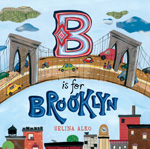 This fun ABC book begins with a map of Brooklyn, a borough of New York City, and an author’s note discussing the layout of the book. Author, Selina Alko, lives in Brooklyn where she writes and illustrates books. Each letter highlights famous landmarks, streets, icons and institutions in Brooklyn. For example, C is for Coney Island, Court Street, Carroll Gardens and Clock Tower. Small child-like illustrations accompany each of these C words along with a gouache and collage illustration of the Coney Island Cyclone roller coaster. Different food stands sell clams, cones, chicken, cotton candy and cheese with a little girl licking strawberry ice cream. Brooklyn is home to many immigrants, therefore I is for Immigrants, Ice cream trucks, Ice-skating and Intellectuals. Each June Brooklyn celebrates the beginning of summer with the Mermaid Parade highlighted for the letter M. This wacky and wonderful parade includes sea creatures, marching bands, drill teams, antique cars and more. After reading this book, children could create their own ABC book about the city or state in which they reside.
This fun ABC book begins with a map of Brooklyn, a borough of New York City, and an author’s note discussing the layout of the book. Author, Selina Alko, lives in Brooklyn where she writes and illustrates books. Each letter highlights famous landmarks, streets, icons and institutions in Brooklyn. For example, C is for Coney Island, Court Street, Carroll Gardens and Clock Tower. Small child-like illustrations accompany each of these C words along with a gouache and collage illustration of the Coney Island Cyclone roller coaster. Different food stands sell clams, cones, chicken, cotton candy and cheese with a little girl licking strawberry ice cream. Brooklyn is home to many immigrants, therefore I is for Immigrants, Ice cream trucks, Ice-skating and Intellectuals. Each June Brooklyn celebrates the beginning of summer with the Mermaid Parade highlighted for the letter M. This wacky and wonderful parade includes sea creatures, marching bands, drill teams, antique cars and more. After reading this book, children could create their own ABC book about the city or state in which they reside.
- Deanna Day, Washington State University Vancouver
Aylesworth, Jim. (2012). Cock-a-doodle-doo, creak, pop-pop, moo. Illus. by Brad Sneed. New York: Holiday House.
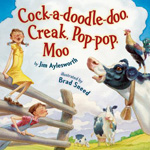 Rhyming lines and onomatopoeia make this nostalgic picture book describing the sights and sounds of life on a family farm rather noisy. Not only do the hard-working family members awaken to the almost-impossible-to-resist smells and sounds of bacon sizzling in the frying pan, but their days are filled with an animal cacophony while they also notice how "breezes swish” (unpaged) later in the day, and how the welcome “clang, clang, clang” (unpaged) of the dinner bell signals that “It's time to eat" (unpaged). Amid all the daily chores and animal noises, there is much fun and support among the family members, and there’s nary a cellphone or a disgruntled countenance among them. Anyone who thinks country living is quiet needs to take a look at this book. Together, the engaging text filled with all those sounds and the watercolor illustrations depicting lots of movement from the farm folks as they complete their tasks evoke feelings of warmth, comfort, and togetherness that make this one fun to read aloud.
Rhyming lines and onomatopoeia make this nostalgic picture book describing the sights and sounds of life on a family farm rather noisy. Not only do the hard-working family members awaken to the almost-impossible-to-resist smells and sounds of bacon sizzling in the frying pan, but their days are filled with an animal cacophony while they also notice how "breezes swish” (unpaged) later in the day, and how the welcome “clang, clang, clang” (unpaged) of the dinner bell signals that “It's time to eat" (unpaged). Amid all the daily chores and animal noises, there is much fun and support among the family members, and there’s nary a cellphone or a disgruntled countenance among them. Anyone who thinks country living is quiet needs to take a look at this book. Together, the engaging text filled with all those sounds and the watercolor illustrations depicting lots of movement from the farm folks as they complete their tasks evoke feelings of warmth, comfort, and togetherness that make this one fun to read aloud.
- Barbara A. Ward, Washington State University Pullman
Brett, Jan. (2012). Mossy. New York: G. P. Putnam’s Sons.
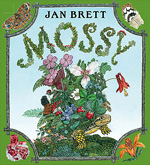 Mossy, an Eastern box turtle, lives by the damp, cool Lilypad Pond. Because she spends so much time there, curlicues of moss begin to grow in her carapace, eventually forming a moss mat which provides the perfect place for ferns and wildflowers to grow. Soon Mossy has an amazing garden she carries on her back. Mossy loves her garden. Each day brings her a lovely surprise—a new flower or a strawberry! Just as Mossy encounters Scoot, a male turtle in the pond, she is picked up by Dr. Carolina, the owner of a local museum. Although Mossy quickly becomes the museum’s star attraction, she seems unhappy and possibly lonely. Two artists, Flora and Fauna, paint a giant picture of Mossy with all her plants, and then Dr. Carolina releases Mossy exactly where she had been found, to Scoot’s delight. The book’s simple text and detailed illustrations with information-filled margins will undoubtedly be a big hit with young readers. Children can spend many hours reading the book and poring over the drawings. A fantastic addition for classrooms, the title will be particularly useful to complement lesson plans and units about habitats and plant-animal interactions. Read more about the author in Kathy Prater's Engage post "Putting Books to Work: Jan Brett's Home for Christmas."
Mossy, an Eastern box turtle, lives by the damp, cool Lilypad Pond. Because she spends so much time there, curlicues of moss begin to grow in her carapace, eventually forming a moss mat which provides the perfect place for ferns and wildflowers to grow. Soon Mossy has an amazing garden she carries on her back. Mossy loves her garden. Each day brings her a lovely surprise—a new flower or a strawberry! Just as Mossy encounters Scoot, a male turtle in the pond, she is picked up by Dr. Carolina, the owner of a local museum. Although Mossy quickly becomes the museum’s star attraction, she seems unhappy and possibly lonely. Two artists, Flora and Fauna, paint a giant picture of Mossy with all her plants, and then Dr. Carolina releases Mossy exactly where she had been found, to Scoot’s delight. The book’s simple text and detailed illustrations with information-filled margins will undoubtedly be a big hit with young readers. Children can spend many hours reading the book and poring over the drawings. A fantastic addition for classrooms, the title will be particularly useful to complement lesson plans and units about habitats and plant-animal interactions. Read more about the author in Kathy Prater's Engage post "Putting Books to Work: Jan Brett's Home for Christmas."
- Rani Iyer, Washington State University Pullman
Katz, Jon. (2012). Lenore finds a friend: A true story from Bedlam farm. New York: Henry Holt.
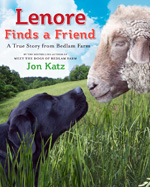 Finding friends to play or eat lunch with isn’t always easy. Just like humans dogs sometimes have this problem too. In bright photographs readers will meet Lenore, a black Labrador retriever, who perseveres and finally makes a friend. As a puppy Lenore tried to make friends with a rooster and donkey, but they crowed or kicked her. Even another dog, Rose, was too busy herding sheep to be friends with Lenore. One day, Lenore met a grumpy ram named Brutus and gave him a big kiss on his nose. Brutus had never been kissed before and didn’t know what to do. The next day Lenore returned and kissed Brutus on the nose again. Rose tried to interfere by barking and growling at this odd animal pairing, but Lenore wouldn’t give up. The next morning she returned to the pasture and found Brutus. They touched noses, ate grass and hung out together. Lenore finally found a friend. Teachers could make a T-chart and invite students to list all of the different things Lenore did to try to make friends. On the other side of the chart students could share what they do to make friends.
Finding friends to play or eat lunch with isn’t always easy. Just like humans dogs sometimes have this problem too. In bright photographs readers will meet Lenore, a black Labrador retriever, who perseveres and finally makes a friend. As a puppy Lenore tried to make friends with a rooster and donkey, but they crowed or kicked her. Even another dog, Rose, was too busy herding sheep to be friends with Lenore. One day, Lenore met a grumpy ram named Brutus and gave him a big kiss on his nose. Brutus had never been kissed before and didn’t know what to do. The next day Lenore returned and kissed Brutus on the nose again. Rose tried to interfere by barking and growling at this odd animal pairing, but Lenore wouldn’t give up. The next morning she returned to the pasture and found Brutus. They touched noses, ate grass and hung out together. Lenore finally found a friend. Teachers could make a T-chart and invite students to list all of the different things Lenore did to try to make friends. On the other side of the chart students could share what they do to make friends.
- Deanna Day, Washington State University Vancouver
McNamara, Margaret. (2012). George Washington’s birthday: A mostly true tale. Illus. by Barry Blitt. New York: Schwartz & Wade Books.
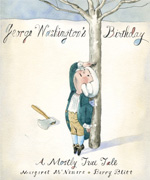 The author has created a humorous look at George Washington’s seventh birthday. When George wakes up on the morning of his birthday he starts dropping hints about his special day but no one seems to pick up on his rather obvious hints. His older brother and teacher insist he begin his studies for the day and his father has him helping with chores around the farm. George continues to drop not-so-subtle hints about what a special day it is and remarks about the cold weather. Throughout the book the author and illustrator have cleverly inserted bordered boxes with Fact or Myth about George Washington. Some of the facts prove to be true later in this future president’s life but many of the myths, particularly the “I cannot tell a lie. It was I who chopped down the tree.” (page 15) are simply fabricated. This will be a humorous read aloud for President’s Day in February though the actual amount of information about the first president is scant. Listen to the author during this NPR interview. Listen to the ReadWriteThink podcast, Chatting About Books, entitled “Celebrate Life” which discusses birthdays.
The author has created a humorous look at George Washington’s seventh birthday. When George wakes up on the morning of his birthday he starts dropping hints about his special day but no one seems to pick up on his rather obvious hints. His older brother and teacher insist he begin his studies for the day and his father has him helping with chores around the farm. George continues to drop not-so-subtle hints about what a special day it is and remarks about the cold weather. Throughout the book the author and illustrator have cleverly inserted bordered boxes with Fact or Myth about George Washington. Some of the facts prove to be true later in this future president’s life but many of the myths, particularly the “I cannot tell a lie. It was I who chopped down the tree.” (page 15) are simply fabricated. This will be a humorous read aloud for President’s Day in February though the actual amount of information about the first president is scant. Listen to the author during this NPR interview. Listen to the ReadWriteThink podcast, Chatting About Books, entitled “Celebrate Life” which discusses birthdays.
- Karen Hildebrand, Ohio Library and Reading Consultant
Schwartz, Amy. (2012). Lucy can’t sleep. New York: Neal Porter/Roaring Brook Press.
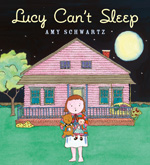 Lucy can’t sleep. She tries counting baby otters, mountain goats, kangaroos and even sailing boats, but none of this counting works. She then realizes Dolly and Bear are missing and begins looking for them throughout her house. The detailed and colorful illustrations show Lucy looking way up high and way down low for her friends. After she finds them it is time for an evening snack of strawberry shortcake and chocolate pudding. Even though the house is quiet and her belly is full, Lucy still isn’t sleepy. Next, she moves outside to swing, stare at the sky and listen to the radio. Not ready to shut her eyes, Lucy begins to play dress up—putting on fancy shoes, gloves and lipstick. After spinning and dancing around Lucy finally yawns. All children will laugh when the final page is read and shared. After reading aloud this book children could discuss what they do when sleep doesn’t come quickly.
Lucy can’t sleep. She tries counting baby otters, mountain goats, kangaroos and even sailing boats, but none of this counting works. She then realizes Dolly and Bear are missing and begins looking for them throughout her house. The detailed and colorful illustrations show Lucy looking way up high and way down low for her friends. After she finds them it is time for an evening snack of strawberry shortcake and chocolate pudding. Even though the house is quiet and her belly is full, Lucy still isn’t sleepy. Next, she moves outside to swing, stare at the sky and listen to the radio. Not ready to shut her eyes, Lucy begins to play dress up—putting on fancy shoes, gloves and lipstick. After spinning and dancing around Lucy finally yawns. All children will laugh when the final page is read and shared. After reading aloud this book children could discuss what they do when sleep doesn’t come quickly.
- Deanna Day, Washington State University Vancouver
GRADES 4-8
Bauer, Joan. (2012). Almost home. New York, Viking.
 Teachers who are looking for multiple genres within one book that includes fiction, poetry, letters and thank you notes, will find that this book is the answer. Sixth grade Sugar Mae Cole lives in Missouri with her mother and grandfather, and part-time father. Mr. Leeland, the name Sugar calls her father, is a gambler and a loser. When things get bad, he disappears. King Cole, Sugar’s grandfather, is able to help them out for a time but shortly after the story opens, he passes away. Now Sugar and her mother are going to lose the family home. It means they are now homeless. Living on the street, going to a shelter and eventually to foster care when her mother falls apart and is hospitalized, Sugar maintains a hopeful attitude that things will get better. There are still ups and downs to her situation but through the emails and poetry of her wonderful sixth grade teacher, Mr. Bennett, and the supporting foster family she is placed with, Sugar carves out a new life for herself while her mother is getting the help she needs. Joan writes more about this book at her blog Toward Home or visit her website to learn more about her award-winning books.
Teachers who are looking for multiple genres within one book that includes fiction, poetry, letters and thank you notes, will find that this book is the answer. Sixth grade Sugar Mae Cole lives in Missouri with her mother and grandfather, and part-time father. Mr. Leeland, the name Sugar calls her father, is a gambler and a loser. When things get bad, he disappears. King Cole, Sugar’s grandfather, is able to help them out for a time but shortly after the story opens, he passes away. Now Sugar and her mother are going to lose the family home. It means they are now homeless. Living on the street, going to a shelter and eventually to foster care when her mother falls apart and is hospitalized, Sugar maintains a hopeful attitude that things will get better. There are still ups and downs to her situation but through the emails and poetry of her wonderful sixth grade teacher, Mr. Bennett, and the supporting foster family she is placed with, Sugar carves out a new life for herself while her mother is getting the help she needs. Joan writes more about this book at her blog Toward Home or visit her website to learn more about her award-winning books.
- Karen Hildebrand, Ohio Library and Reading Consultant
Cox, Judy. (2012). The secret chicken society. Illus. by Amanda Haley. New York: Holiday House.
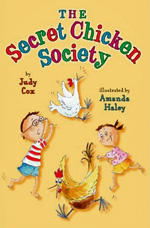 Mrs. Lopez is Daniel’s third grade teacher. One day she announces that the next science project for the class will be watching and hatching chicken eggs as they develop in the class incubator. Daniel is especially excited to learn that there will be a drawing to see who gets to keep the chickens at the end of the year. Being an animal lover and owner of several pets already he convinces his environmentally friendly father right away but his mother is a little more reluctant to give her okay to one more pet. Daniel barely manages to get his name drawn while other kids learn that their parents will not agree to a take-home baby chick so Daniel ends up with five baby chickens. His brother and sisters help him set up their backyard to raise the chickens but his elderly neighbor, Mr. Grafalo is even grumpier than usual when he sees the chickens. Mrs. Grafalo however is delighted because the chicks remind her of her youthful days growing up on a farm. As the chickens grow, the family is in for a surprise when one turns out to be a rooster, which is illegal in the city. Now how is Daniel going to keep a crowing rooster a secret? The author has included Daniel’s journal at the end of the book that contains all the facts he learned about raising chickens. Learn more about the author at her website or the FaceBook page for this book. For further study, check out the website GREEN AMERICAN and read the article,"The Many Benefits of Backyard Chickens." ReadWriteThink offers other books about chickens and ideas and activities for using these books. Also read Kathy Prater's Engage post "Putting Books to Work: Judy Cox's One is a Feast for a Mouse: A Thanksgiving Tale."
Mrs. Lopez is Daniel’s third grade teacher. One day she announces that the next science project for the class will be watching and hatching chicken eggs as they develop in the class incubator. Daniel is especially excited to learn that there will be a drawing to see who gets to keep the chickens at the end of the year. Being an animal lover and owner of several pets already he convinces his environmentally friendly father right away but his mother is a little more reluctant to give her okay to one more pet. Daniel barely manages to get his name drawn while other kids learn that their parents will not agree to a take-home baby chick so Daniel ends up with five baby chickens. His brother and sisters help him set up their backyard to raise the chickens but his elderly neighbor, Mr. Grafalo is even grumpier than usual when he sees the chickens. Mrs. Grafalo however is delighted because the chicks remind her of her youthful days growing up on a farm. As the chickens grow, the family is in for a surprise when one turns out to be a rooster, which is illegal in the city. Now how is Daniel going to keep a crowing rooster a secret? The author has included Daniel’s journal at the end of the book that contains all the facts he learned about raising chickens. Learn more about the author at her website or the FaceBook page for this book. For further study, check out the website GREEN AMERICAN and read the article,"The Many Benefits of Backyard Chickens." ReadWriteThink offers other books about chickens and ideas and activities for using these books. Also read Kathy Prater's Engage post "Putting Books to Work: Judy Cox's One is a Feast for a Mouse: A Thanksgiving Tale."
- Karen Hildebrand, Ohio Library and Reading Consultant
King, Martin Luther King, Jr. (2012). I have a dream. Paintings by Kadir Nelson. New York: Schwartz & Wade Books.
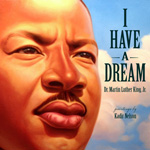 On August 28, 1968, on the day of the March on Washington D.C., Martin Luther King, Jr., delivered his famous “I Have a Dream” speech on the steps of the Lincoln Memorial. The publishers have included a CD of the actual speech in this beautifully illustrated version of the famous speech. Nelson’s oil paintings taken page by page make Dr. King’s ideas come alive for young readers today. Each page and double page spread represent the concepts that Dr. King was so emphatically purporting at the time, representing peace and justice and freedom in a world where blacks and whites would live together in harmony. Listen and watch Kadir Nelson discuss this new book from his speech at Book Expo America or watch Martin Luther King give his speech at You Tube. Teachers might like to try the interactive “Word Mover for ‘I Have a Dream’” from ReadWriteThink.
On August 28, 1968, on the day of the March on Washington D.C., Martin Luther King, Jr., delivered his famous “I Have a Dream” speech on the steps of the Lincoln Memorial. The publishers have included a CD of the actual speech in this beautifully illustrated version of the famous speech. Nelson’s oil paintings taken page by page make Dr. King’s ideas come alive for young readers today. Each page and double page spread represent the concepts that Dr. King was so emphatically purporting at the time, representing peace and justice and freedom in a world where blacks and whites would live together in harmony. Listen and watch Kadir Nelson discuss this new book from his speech at Book Expo America or watch Martin Luther King give his speech at You Tube. Teachers might like to try the interactive “Word Mover for ‘I Have a Dream’” from ReadWriteThink.
- Karen Hildebrand, Ohio Library and Reading Consultant
Laverdunt, Damien. (2012). Small and tall tales of extinct animals. Illus. by Helene Rajcak. Minneapolis, MN: Lerner Publishing Group/Gecko Press.
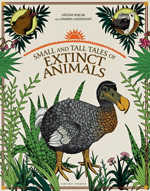 Through a series of cartoons, legends, myths, and tall tales, readers are taken on an around-the-world tour of animals that are gone but not forgotten. By using intriguing elements from both science and mythology, essentially incorporating facts and legends, the title makes readers think about the possibilities of a world in which huge beavers could gnaw down trees or dodos could waddle through fields while elephant-birds filled the skies. Young readers will surely be intrigued by the stories about the giant lemur and the woolly mammoth, and several other hard-to-say animals who once called this planet home. Particularly appealing are the questions posed about the future of some of the animals related to those that are now gone. This would be a great addition to any classroom science library and may inspire more thoughtful conservation efforts from today’s students.
Through a series of cartoons, legends, myths, and tall tales, readers are taken on an around-the-world tour of animals that are gone but not forgotten. By using intriguing elements from both science and mythology, essentially incorporating facts and legends, the title makes readers think about the possibilities of a world in which huge beavers could gnaw down trees or dodos could waddle through fields while elephant-birds filled the skies. Young readers will surely be intrigued by the stories about the giant lemur and the woolly mammoth, and several other hard-to-say animals who once called this planet home. Particularly appealing are the questions posed about the future of some of the animals related to those that are now gone. This would be a great addition to any classroom science library and may inspire more thoughtful conservation efforts from today’s students.
- Barbara A. Ward, Washington State University Pullman
Murphy, Jim. (2012). The giant and how he humbugged America. New York: Scholastic Press.
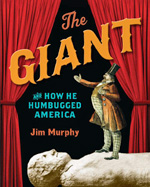 The Cardiff Giant, a 10-foot tall stone man, was discovered on a farm in upstate New York on October 16, 1869, owned by William Newell. It started when Henry Nichols and Gideon Emmons went to Newell’s farm to dig a well. Several hours of digging eventually unearthed the stone giant and the questions began. What was this huge being? A legend from the Onondaga Indians? Was it actually a real man? Within days, people were line up paying money to Mr. Newell to see the strange sight. Circus entrepreneur, P. T. Barnum got involved and created a duplicate for his circus entourage. Eventually, the scientists came and within months, the gypsum giant was declared a hoax. Jim Murphy’s talent for collecting newspaper articles, vintage photographs, posters and other primary sources combine to revisit the times that brought this post-Civil War diversion to the public and expose the truth with scientific proof and experiments. Murphy provides lengthy and detailed indexes and resources about his research at the end of the book. Learn more about author Jim Murphy at his website or read more about the back story at School Library Journal. For a visual lesson, teachers might like to show the CBC News Video report on the Cardiff Giant. Just as scientists worked on this puzzle, teachers might like to use “Giant Story Problems; Reading Comprehension through Math Problem-Solving” at ReadWriteThink.
The Cardiff Giant, a 10-foot tall stone man, was discovered on a farm in upstate New York on October 16, 1869, owned by William Newell. It started when Henry Nichols and Gideon Emmons went to Newell’s farm to dig a well. Several hours of digging eventually unearthed the stone giant and the questions began. What was this huge being? A legend from the Onondaga Indians? Was it actually a real man? Within days, people were line up paying money to Mr. Newell to see the strange sight. Circus entrepreneur, P. T. Barnum got involved and created a duplicate for his circus entourage. Eventually, the scientists came and within months, the gypsum giant was declared a hoax. Jim Murphy’s talent for collecting newspaper articles, vintage photographs, posters and other primary sources combine to revisit the times that brought this post-Civil War diversion to the public and expose the truth with scientific proof and experiments. Murphy provides lengthy and detailed indexes and resources about his research at the end of the book. Learn more about author Jim Murphy at his website or read more about the back story at School Library Journal. For a visual lesson, teachers might like to show the CBC News Video report on the Cardiff Giant. Just as scientists worked on this puzzle, teachers might like to use “Giant Story Problems; Reading Comprehension through Math Problem-Solving” at ReadWriteThink.
- Karen Hildebrand, Ohio Library and Reading Consultant
Sobol, Richard. (2012). The story of silk: From worm spit to woven scarves. Somerville, MA: Candlewick Press.
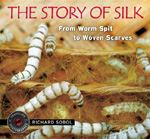 Author/photographer Richard Sobol returns to the small Thai village where he did his research for his book, The Life Of Rice (2010). He planned to share the new book with the people in the village. When he arrived he discovers they are in the midst of silk season, meaning it is a dry-season activity. The young men of the village are away at school and the silk production industry of the village is in the hands of the women. Sobol writes his book as a learner, asking questions about how silk is actually produced from start to finish. Through his photographs and basic textual information, the readers watches the development of the silk worms, the baskets where they munch fresh mulberry leaves, the pupa stage creating the cocoons, until the cocoons are carefully harvested, boiled, dyed and woven into beautiful fabric known the world over. The author has included a glossary and other useful facts about silk production at the end of the book. To learn more about this author and background information about silk, visit his Traveling Photographer website. Teachers might like to try the Nonfiction Pyramid lesson and graphic organizer found at ReadWriteThink.
Author/photographer Richard Sobol returns to the small Thai village where he did his research for his book, The Life Of Rice (2010). He planned to share the new book with the people in the village. When he arrived he discovers they are in the midst of silk season, meaning it is a dry-season activity. The young men of the village are away at school and the silk production industry of the village is in the hands of the women. Sobol writes his book as a learner, asking questions about how silk is actually produced from start to finish. Through his photographs and basic textual information, the readers watches the development of the silk worms, the baskets where they munch fresh mulberry leaves, the pupa stage creating the cocoons, until the cocoons are carefully harvested, boiled, dyed and woven into beautiful fabric known the world over. The author has included a glossary and other useful facts about silk production at the end of the book. To learn more about this author and background information about silk, visit his Traveling Photographer website. Teachers might like to try the Nonfiction Pyramid lesson and graphic organizer found at ReadWriteThink.
- Karen Hildebrand, Ohio Library and Reading Consultant
GRADES 9-12
Carson, Rae. (2012). Crown of embers. New York: Greenwillow Books.
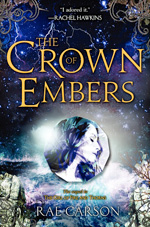 In this sequel to The Girl of Fire and Thorns (2011), Elisa is now Queen of Joya d’Arena but her life is in danger. Being pressured by her council to remarry soon to build political alliances and yet finding unrest in the kingdom, she is reluctant to rush into a marriage. Though she thoroughly accepts her responsibilities as ruler, she is also falling in love with her protector, though it is a love than cannot be. As Elisa learns more about her new country and is guided by the pulsating Godstone in her belly, she embarks on a voyage to discover and learn about the zafira, the soul of the world. Her life is threatened at every turn and the people that surround her have questionable loyalties. Who can she trust? What must she do next? As she works toward these difficult decisions, the enemy Inviernos invade her camp by means of a traitor and the end of the book has a cliffhanger that will leave readers anxiously awaiting the end of the trilogy. Visit the author’s website to learn more about this planned trilogy. Listen to Chapter One, Part 1 from the audiobook. Teachers can look for more fantasy recommendations at ReadWriteThink’s “Feminist Books for Teens.”
In this sequel to The Girl of Fire and Thorns (2011), Elisa is now Queen of Joya d’Arena but her life is in danger. Being pressured by her council to remarry soon to build political alliances and yet finding unrest in the kingdom, she is reluctant to rush into a marriage. Though she thoroughly accepts her responsibilities as ruler, she is also falling in love with her protector, though it is a love than cannot be. As Elisa learns more about her new country and is guided by the pulsating Godstone in her belly, she embarks on a voyage to discover and learn about the zafira, the soul of the world. Her life is threatened at every turn and the people that surround her have questionable loyalties. Who can she trust? What must she do next? As she works toward these difficult decisions, the enemy Inviernos invade her camp by means of a traitor and the end of the book has a cliffhanger that will leave readers anxiously awaiting the end of the trilogy. Visit the author’s website to learn more about this planned trilogy. Listen to Chapter One, Part 1 from the audiobook. Teachers can look for more fantasy recommendations at ReadWriteThink’s “Feminist Books for Teens.”
- Karen Hildebrand, Ohio Library and Reading Consultant
Clayton, Colleen. (2012). What happens next. New York: Little, Brown Books/Poppy.
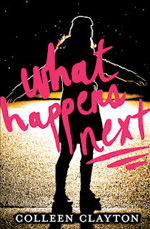 A high school ski club trip to the slopes ends up changing the life of sixteen-year-old cheerleader Sid Murphy when she is date raped but unable to remember anything about the incident. She tells no one what little she can remember about what happened, not even her mother or two best friends, Kirsten and Paige. Her initial avoidance of her friends angers them, and they shun her at school, leaving her to fend for herself. When she volunteers to work in the AV room rather than attend one of her classes, she is at first repulsed and then attracted to Corey Livingston, a classmate with a reputation as a drug dealer. As the two grow closer, Sid starts seeing herself and Corey differently. But there's just this "little" thing that keeps her off guard—how she was raped by someone she thought she could trust. Desperate to erase the voluptuous parts of her that seem to attract male attention, Sid began running at all hours of the night and eating next to nothing. She clearly needs help, but she keeps everyone at arm’s length. The author has created a likeable but understandably confused character in Sid while exploring her emotions and actions thoroughly. Because she feels as though she has so little control over many parts of her life, she controls the things she can control. Recognizing their own high school years when gossip and assumptions prompt drama, many teen readers are sure to race through the pages of the book to find out what happens next. In the end, while everything doesn’t turn out perfectly for Sid, she has the resources to survive and to begin to heal.
A high school ski club trip to the slopes ends up changing the life of sixteen-year-old cheerleader Sid Murphy when she is date raped but unable to remember anything about the incident. She tells no one what little she can remember about what happened, not even her mother or two best friends, Kirsten and Paige. Her initial avoidance of her friends angers them, and they shun her at school, leaving her to fend for herself. When she volunteers to work in the AV room rather than attend one of her classes, she is at first repulsed and then attracted to Corey Livingston, a classmate with a reputation as a drug dealer. As the two grow closer, Sid starts seeing herself and Corey differently. But there's just this "little" thing that keeps her off guard—how she was raped by someone she thought she could trust. Desperate to erase the voluptuous parts of her that seem to attract male attention, Sid began running at all hours of the night and eating next to nothing. She clearly needs help, but she keeps everyone at arm’s length. The author has created a likeable but understandably confused character in Sid while exploring her emotions and actions thoroughly. Because she feels as though she has so little control over many parts of her life, she controls the things she can control. Recognizing their own high school years when gossip and assumptions prompt drama, many teen readers are sure to race through the pages of the book to find out what happens next. In the end, while everything doesn’t turn out perfectly for Sid, she has the resources to survive and to begin to heal.
- Barbara A. Ward, Washington State University Pullman
Reef, Catherine. (2012). The Bronte sisters: The brief lives of Charlotte, Emily, and Anne. New York/Boston: Houghton Mifflin Harcourt/Clarion Books.
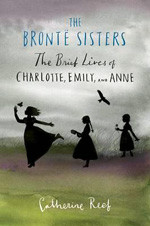 This new biography provides glimpses into the lives, times, and personalities of the Bronte family. Surprisingly, three daughters of a minister who lived in Haworth in the north part of England all wrote and had books published during a time when the expected lot of women was marriage and family and few published women writers. To read this carefully-researched biography is to learn about loss--the death of the girls' mother a few months after giving birth to her last child, the early deaths of two Bronte girls, the early promise and later dissipation and wasted potential of their brother Branwell, the deaths of Anne, Emily, and Branwell, all within an eight month period. But their lives weren't always filled with loss and bleakness; as children, the creative siblings played games and invented characters and stories, drawing strength from one another. The fact that even today Jane Eyre and Wuthering Heights remain in print and are widely read refutes those who claimed that women were incapable of creating lasting works of literature. This is a superb introduction to three intriguing women, providing as it does, a study into their characters, but also an examination of times when women's rights were restricted and health care was rudimentary at best. Teen readers may ponder what other stories were left untold by the early demise of these women, all of whom died when they were in their thirties. Back matter includes notes and a bibliography for those who are curious to learn even more. English teachers will certainly want to add this to their bookshelves for the insight it gives into writing and Charlotte's stubborn refusal to change a word of Jane Eyre when it was published.
This new biography provides glimpses into the lives, times, and personalities of the Bronte family. Surprisingly, three daughters of a minister who lived in Haworth in the north part of England all wrote and had books published during a time when the expected lot of women was marriage and family and few published women writers. To read this carefully-researched biography is to learn about loss--the death of the girls' mother a few months after giving birth to her last child, the early deaths of two Bronte girls, the early promise and later dissipation and wasted potential of their brother Branwell, the deaths of Anne, Emily, and Branwell, all within an eight month period. But their lives weren't always filled with loss and bleakness; as children, the creative siblings played games and invented characters and stories, drawing strength from one another. The fact that even today Jane Eyre and Wuthering Heights remain in print and are widely read refutes those who claimed that women were incapable of creating lasting works of literature. This is a superb introduction to three intriguing women, providing as it does, a study into their characters, but also an examination of times when women's rights were restricted and health care was rudimentary at best. Teen readers may ponder what other stories were left untold by the early demise of these women, all of whom died when they were in their thirties. Back matter includes notes and a bibliography for those who are curious to learn even more. English teachers will certainly want to add this to their bookshelves for the insight it gives into writing and Charlotte's stubborn refusal to change a word of Jane Eyre when it was published.
- Barbara A. Ward, Washington State University Pullman.
Willner-Pardo, Gina. (2012). Prettiest doll. New York/Boston: Houghton Mifflin Harcourt/ Clarion Books.
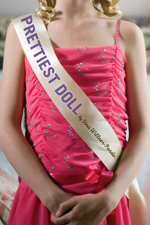 All of her life thirteen-year-old Olivia Jane Tatum has heard how lucky she is to be so pretty. Yes, she knows she is fortunate, but she also longs to be known for much more than her looks. From the book’s opening pages, it’s clear that it’s only a matter of time before Olivia leaves the beauty pageant circuit with its endless rounds of walking, smiling, answering questions, posing in gowns, and searching for a talent that will impress the judges. But after she's no longer defining herself through her looks, how will she know who she actually is? The author does a good job of describing the small town world of Luthers Bridge, Missouri, where Olivia lives and her concern about who she is beneath all that pageantry finery, makeup, hairstyle, and smiles. A chance meeting with Danny, a fifteen-year-old runaway on his way to Chicago because he doesn't want to give in to his own mother's pressure to take growth hormone shots so he can grow taller, leads her to accompany him to Chicago in order to settle some of her own issues. Olivia’s journey to Chicago leads to the realization that being true to herself and following her own dreams rather than her mother's will make her a winner in the end. Readers will enjoy getting a glimpse into the life of someone for whom her appearance has been a ticket to success--or has it?
All of her life thirteen-year-old Olivia Jane Tatum has heard how lucky she is to be so pretty. Yes, she knows she is fortunate, but she also longs to be known for much more than her looks. From the book’s opening pages, it’s clear that it’s only a matter of time before Olivia leaves the beauty pageant circuit with its endless rounds of walking, smiling, answering questions, posing in gowns, and searching for a talent that will impress the judges. But after she's no longer defining herself through her looks, how will she know who she actually is? The author does a good job of describing the small town world of Luthers Bridge, Missouri, where Olivia lives and her concern about who she is beneath all that pageantry finery, makeup, hairstyle, and smiles. A chance meeting with Danny, a fifteen-year-old runaway on his way to Chicago because he doesn't want to give in to his own mother's pressure to take growth hormone shots so he can grow taller, leads her to accompany him to Chicago in order to settle some of her own issues. Olivia’s journey to Chicago leads to the realization that being true to herself and following her own dreams rather than her mother's will make her a winner in the end. Readers will enjoy getting a glimpse into the life of someone for whom her appearance has been a ticket to success--or has it?
- Barbara A. Ward, Washington State University Pullman
These reviews are submitted by members of the International Reading Association's Children's Literature and Reading Special Interest Group (CL/R SIG) and are published weekly on Reading Today Online. The International Reading Association partners with the National Council of Teachers of English and Verizon Thinkfinity to produce ReadWriteThink.org, a website devoted to providing literacy instruction and interactive resources for grades K–12.